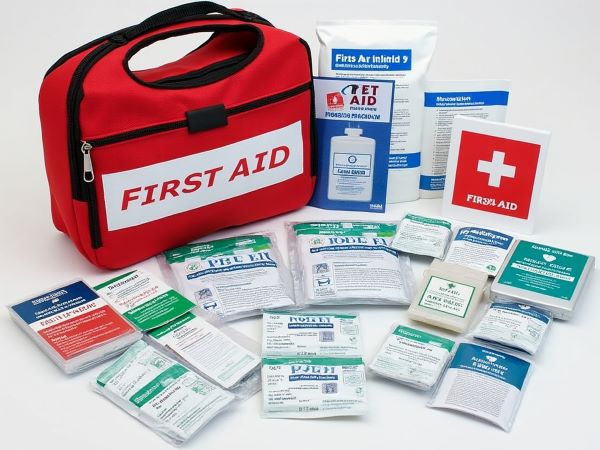| Malta Short Let: Cozy Stay in Gzira | |
|
Sliema Area Modern Designer Finished 2 Bedrooms + Games Room. First floor with Maltese Balcony Large back Terrace with swinging sofa Fully Airconditioned + Full Kitchen 3 TVs, including 65” with backlight. |
 |
|
Book Now: Google Travel | Direct (Cheapest) | Booking.com | Airbnb |
|
When you’re heading out for a weekend city escape or an adventure in the wild, a well-prepared first aid kit is essential for staying safe on the road. You don’t need to be a medical expert to manage minor mishaps, but having the right items on hand can help you feel confident and ready. Below is a general guide for building a versatile travel first aid kit, suitable for a range of travel scenarios. Note: This information is for general travel safety and is not a substitute for professional medical advice.
The Essentials: What Every First Aid Kit Needs
Every travel first aid kit should have certain core items, regardless of the destination or type of trip. These essentials cover common minor injuries and are safe for general use. Remember, if you have a more serious injury or illness, seek professional medical attention as soon as possible.
Band-Aids & Blister Plasters
Cuts, scrapes, and blisters are frequent travel mishaps. Bring a small variety of Band-Aids in different sizes, and if you’re planning to explore historic sites, hike heritage trails, or visit ancient temples, add blister plasters to prevent chafing in new shoes.
Gauze Pads
Gauze is essential for covering wounds or applying pressure to control bleeding. Use sterile, individually wrapped squares to help keep wounds clean. Tip: Only apply gauze with clean hands, and change dressings regularly to prevent infection.
Elastic Bandages (Crepe Bandages)
These bandages can wrap and secure minor injuries, but they are not a replacement for medical care. Only use elastic bandages as a temporary measure until you can reach professional help if needed.
Surgical Tape
Ideal for keeping gauze or dressings in place, surgical tape can be helpful in areas where Band-Aids might not adhere well. Be cautious to avoid allergic reactions if you have sensitive skin.
Small Scissors
Scissors can be helpful for trimming gauze or cutting tape, but make sure they’re TSA-compliant if traveling with a carry-on.
Tweezers
Tweezers are useful for splinter or tick removal but should be sterilized before and after each use. Avoid using them near sensitive areas such as the eyes.
Antiseptic Wipes
Essential for cleaning wounds to prevent infection. Antiseptic wipes should be used with caution around sensitive skin and only on minor cuts or scrapes. Always check for skin reactions.
Pain Relief Medication
A small amount of over-the-counter pain reliever, such as acetaminophen or ibuprofen, is generally safe for minor aches or headaches. Important: Use as directed on the packaging, and be mindful of allergies or contraindications.
Anti-Diarrheal Tablets (Loperamide)
Loperamide is suitable for emergency use if you’re experiencing diarrhea and need to travel. These tablets should only be used as directed on the packaging and are not meant to treat underlying causes of diarrhea.
Antihistamine Cream
Useful for mild itching or irritation due to insect bites. Avoid applying to broken skin or near the eyes. If irritation persists, discontinue use and seek advice from a healthcare professional.
Antibacterial Cream
For minor cuts, antibacterial creams may help prevent infection and speed healing. Follow directions on the packaging and consult a pharmacist if you have concerns.
Add-Ons by Travel Type
Depending on the nature of your travels, you may need additional items tailored to specific activities or travel styles. Remember, these add-ons should be used in accordance with instructions and not as substitutes for professional medical care.
Solo Traveler
For solo travel, consider these extra items for added security.
- Extra Band-Aids & Blister Plasters: Extra supplies are helpful if you don’t have a travel companion to borrow from.
- Condoms: These can be versatile, serving as emergency water carriers or ice packs.
- Emergency Contact Card: Include local emergency numbers and note any health conditions or allergies in case of emergency.
Couple
Traveling as a couple lets you share supplies and prepare for intimate moments.
- Mini Hand Sanitizer: Use to clean hands before handling food or wounds, especially in shared spaces.
- After-Sun Lotion or Aloe Gel: Helps soothe sunburn and is especially useful if you’re spending time outdoors together.
Family with Kids
When traveling with children, it’s important to be ready for kid-friendly care.
- Child-Safe Pain Relief (e.g., Children’s Acetaminophen): Always check age suitability and dosage instructions.
- Band-Aids with Fun Designs: Kid-friendly designs can help make minor injuries less intimidating for young ones.
- Calamine Lotion or Anti-Itch Cream: Helpful for insect bites but should not be used on large skin areas without consulting a professional.
- Thermometer: A simple thermometer helps monitor fevers and is useful for determining when to seek medical care.
- After-Bite Cream: These creams provide relief from minor bites and stings.
Sports Traveler
If you’re traveling for athletic activities like mountain biking or rock climbing, be ready with these specific items.
- Muscle Rub or Pain Relief Gel: For sore muscles after physical activity.
- Elastic Bandage Wraps: Useful for minor sprains but should only be applied as a temporary measure.
- Electrolyte Tablets: Helpful for hydration after intense activities but should be used as directed.
- Instant Cold Pack: Provides temporary relief for swelling, especially useful for sprains or bruises.
- Finger Splints: Only use if you’re comfortable with splinting techniques; improper use can worsen injuries.
Adventure Seeker
For remote or rugged destinations, an enhanced kit can offer some peace of mind.
- Sterile Needles & Syringes: Only bring these if trained and traveling to areas with limited medical care.
- Water Purification Tablets: Useful for ensuring safe drinking water in remote areas.
- Extra Gauze & Dressings: Essential for treating larger wounds if you’re far from help.
- Burn Cream: Particularly helpful for minor burns from campfires or cooking.
- Flashlight: In emergency situations, a flashlight aids nighttime wound care or safe movement in dark environments.
Malta Add-Ons
If you’re heading to Malta, here are a few items that can be especially useful in this Mediterranean environment:
- Jellyfish Sting Relief Gel: If you’re swimming in Malta, a sting-relief gel or vinegar can help neutralize jellyfish stings.
- Burn Cream or Aloe for BBQs or Bonfires: Outdoor cooking is common in Malta, so keep burn relief on hand.
- High SPF Sunscreen & After-Sun Lotion: Malta’s intense sun requires strong sun protection, plus after-sun care for any overexposure.
- Insect Repellent & Anti-Itch Cream: Malta has a fair number of mosquitoes in the summer, so be ready for bites.
- Hangover Cure Kit (We really emphasis the responsible use of alcohol but …_): Malta’s nightlife is active, so bring rehydration tablets, pain relief, and stomach-settling options as needed.
Final Tips for Building Your Kit
Customizing your first aid kit allows you to be well-prepared, and it’s always wise to consider your destination, planned activities, and any individual health needs. Always check expiration dates and keep medications in their original packaging to ensure they’re safe and easy to identify. Important: For any injury or illness that requires more than basic first aid, seek professional medical help as soon as possible.
Disclaimer: This guide is intended for general information only. Always consult a healthcare professional before using any medication or first aid supplies, especially if you have pre-existing conditions or allergies. For serious injuries or symptoms, professional medical treatment is essential.








